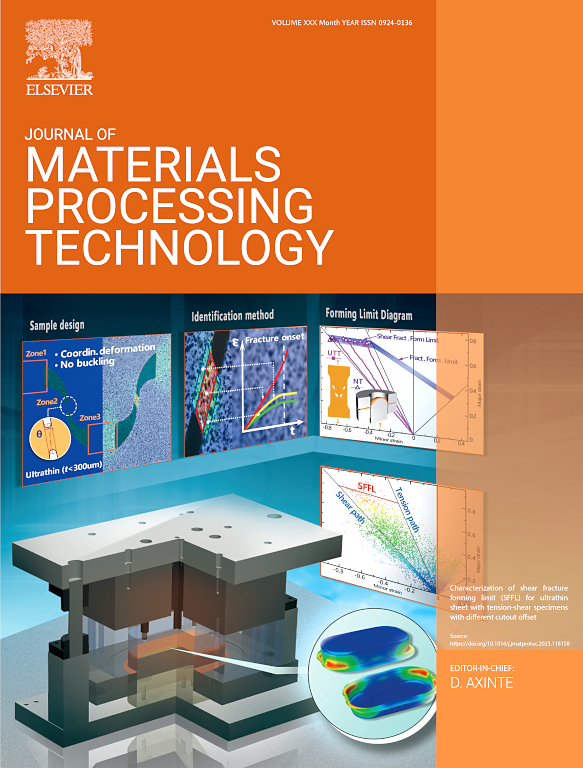通过对双电层行为的分析,阐明了双极脉冲和辅助电极的电化学加工机理
IF 6.7
2区 材料科学
Q1 ENGINEERING, INDUSTRIAL
Journal of Materials Processing Technology
Pub Date : 2025-05-19
DOI:10.1016/j.jmatprotec.2025.118907
引用次数: 0
摘要
电化学加工(ECM)以其表面光洁度高、刀具无磨损、无残余应力等优点成为非常规加工中最具发展前景的技术之一。为了实现电解加工中材料高度局部溶解的高精度加工,需要采取有效措施克服杂散腐蚀,这是影响电解加工精度的关键问题。已有研究表明,利用双极脉冲和辅助电极(BPAE-ECM)进行电化学加工可以大大提高加工精度和效率。然而,该方法的潜在机制尚不清楚,特别是双电层(EDL)行为的作用。本研究基于电化学系统的信号处理,通过对EDL行为的分析,阐明了其机理。简而言之,该机制涉及一种中和效应,即利用负脉冲提供的反向电荷抵消非加工区域EDL中的正脉冲电荷,从而有效地降低法拉第电流,提高加工精度。通过仿真和实验验证了其机理。与传统的单极脉冲电解加工(UP-ECM)相比,模拟等效电路的信号表明,BPAE-ECM可以大大降低非加工区域的EDL过电位和法拉第电流。相应的实验结果表明,杂散腐蚀明显降低。此外,还对具有较高形状精度的结构进行了加工,以验证BPAE-ECM的能力。本文章由计算机程序翻译,如有差异,请以英文原文为准。
Electrochemical machining mechanism with bipolar pulses and auxiliary electrode elucidated by analyzing behavior of electric double layer
Electrochemical machining (ECM) has become one of the most promising technologies in non-conventional machining due to its high quality in surface finish, no tool wear, and no residual stress. To achieve high-precision machining with highly-localized material dissolution in ECM, effective measures need to be taken to overcome stray corrosion, which is the critical issue hindering ECM accuracy. Previous work has shown that electrochemical machining with bipolar pulses and auxiliary electrode (BPAE-ECM) can greatly improve machining accuracy and efficiency. However, the underlying mechanism of the proposed method is still unclear, especially the role of the behavior of the electric double layer (EDL). This study clarifies the mechanism through analyzing the behavior of the EDL based on signal processing of the electrochemical system. Briefly, the mechanism involves a neutralizing effect, in which the reverse charges provided by the negative-pulse are utilized to counteract the positive-pulse charges in the EDL of the non-machining area, which effectively reduces the Faradaic current to improve machining accuracy. The mechanism was verified by simulations and experiments. In contrast to conventional ECM with unipolar pulse (UP-ECM), the signals from the simulated equivalent circuit show that the EDL overpotential and Faradaic current of the non-machining area can be reduced greatly by BPAE-ECM. Corresponding experimental results show that stray corrosion is significantly reduced. Furthermore, structures with high shape accuracy are machined to demonstrate the capability of BPAE-ECM.
求助全文
通过发布文献求助,成功后即可免费获取论文全文。
去求助
来源期刊

Journal of Materials Processing Technology
工程技术-材料科学:综合
CiteScore
12.60
自引率
4.80%
发文量
403
审稿时长
29 days
期刊介绍:
The Journal of Materials Processing Technology covers the processing techniques used in manufacturing components from metals and other materials. The journal aims to publish full research papers of original, significant and rigorous work and so to contribute to increased production efficiency and improved component performance.
Areas of interest to the journal include:
• Casting, forming and machining
• Additive processing and joining technologies
• The evolution of material properties under the specific conditions met in manufacturing processes
• Surface engineering when it relates specifically to a manufacturing process
• Design and behavior of equipment and tools.
 求助内容:
求助内容: 应助结果提醒方式:
应助结果提醒方式:


